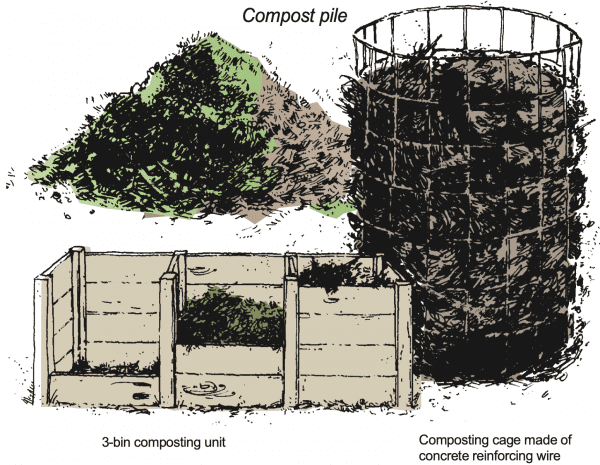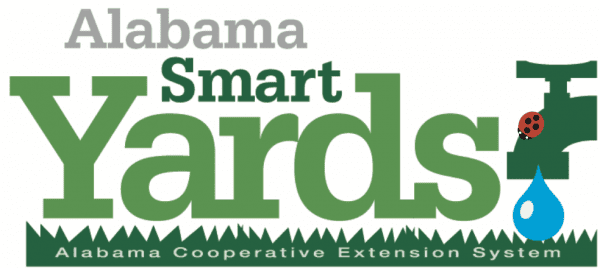Landscaping

In Alabama, a family of four generates an average of 2.5 tons of garbage per year—nearly a half ton of which is yard refuse and kitchen waste that can be composted. Learn everything from how to construct your compost pile in layers to how to manage the carbon/nitrogen ratio and regulate temperature, as well as how to use finished compost for adding nutrients to your soil, conserving moisture, and suppressing weeds.
According to the EPA, Americans recycle and compost about 33 percent of their total daily trash generated. However, roughly 75 percent of all municipal waste is material that could be recycled. The magnitude of solid waste production is presenting disposal problems in sanitary landfills. Many landfills have been forced to close as a result of being full or environmentally unsound.
You can have an impact on decreasing the volume of trash in our landfills and add a benefit to your yard at the same time. Recycle leaves and other yard waste and most kitchen scraps to make your own compost. It gives benefit to both sandy and clay soils. Why buy this amendment when you can make it yourself?
The key to composting in the home landscape is to regulate the conditions under which microbial decomposition takes place for greater efficiency.
Keep in mind that smart yard composting is merely speeding up a natural process. On the forest floor, it could take several years for humus (or compost) to form, but with attention to detail, we can shorten this to mere weeks.
The Compost Environment
For efficient and rapid composting, the micro-organisms that do the work need to have the right balance of air, water, carbon, nitrogen, and temperature.

Compost pile. 3-bin composting unit. Composting cage made of concrete reinforcing wire.
Air
Composting is an aerobic process, which means it occurs in the presence of oxygen. The compost pile gets oxygen two ways: (1) by the turning of compost, and (2) by building the pile so surface air can diffuse into the center. When a pile gets too little oxygen, it will become anaerobic, and offensive odors can result.
Water
Micro-organisms need water to survive and function. Ideally, the moisture content of the compost pile should be between 40 and 60 percent. The compost should be moist when squeezed but not dripping wet. If too wet, the decomposition process will slow down.
Carbon and Nitrogen
The micro-organisms that do the composting need food. They get energy from materials high in carbon (carbohydrates such as cellulose, lignin, and complex sugars in plant residues). They also need protein, which they manufacture from materials high in nitrogen (manures, kitchen scraps, green leaves, and fertilizer nitrogen).
The ratio of carbon (C) to nitrogen (N) is important. If there is too little N, the microbial population will not grow to an optimum size, and decomposition will slow down. On the other hand, while too much N compared to C allows rapid microbial growth and speeds up decomposition, it can result in depleted oxygen and odors as the excess N is given off as ammonia gas. The optimum C:N ratio is about 30:1.
If materials added to the pile have a high C:N ratio, then some N should be added to more closely approximate an optimum C:N ratio. For example, if sawdust is placed in the pile, then some N fertilizer, grass clippings, or manure should be added at the same time.
Knowing that the carbon in dead leaves is much more available than carbon in large wood chips, it’s important to increase surface area. Small chips give the micro-organisms more surface area on which to feed. A leaf shredder or chipper prepares all compost materials for a more efficient compost process.
Carbon to Nitrogen Ratio
*Drier materials have a higher carbon percentage than fresher materials.
| Dried Material | C:N Ratio |
|---|---|
| sawdust | 200-750:1* |
| pine straw | 70:1 |
| horse manure | 20-50:1* |
| poultry manure | 3-15:1* |
| leaves | 40-80:1* |
| grass clippings | 15-20:1* |
| vegetable waste | 12-20:1* |
| wood chips | 100-500:1* |
| corrugated cardboard | 550:1 |
| coffee grounds | 20:1 |
| paper | 170:1 |
Temperature
As the micro-organisms grow and multiply, they generate heat from metabolism. Heat is beneficial in that it destroys many kinds of weed seed and disease organisms; however, when temperatures rise above 140°F, the beneficial micro-organisms start to die.
Turning the pile when temperatures reach this point will prevent overheating and will speed up the entire process.
Managing the Composting Process
Any number of systems may be used to contain and manage compost. But any compost system that you choose should be determined by how well you will be able to manage the compost process. Whether using a cage, a pile, or a turning unit, the following sequence should be followed to properly build and manage the compost.
Construct a compost pile in layers. Alternate different types of yard waste with a nitrogen source and a sprinkling of soil or finished compost. The soil and finished compost provide an inoculum of micro-organisms. Begin with a 6-inch layer of coarse materials such as small twigs or branches (this adds air). Then place finer materials such as leaves or grass clippings in a layer about 6 to 8 inches deep. If wood chips or other higher-carbon materials are placed in this layer instead of leaves or grass clippings, add about 1 cup of a nitrogen fertilizer or a manure. The final layer consists of soil or finished compost 1 to 2 inches deep.
This sequence of layers is repeated with the exception that the coarser material is omitted with subsequent layers. Just about any plant waste can be added to the compost pile. Kitchen scraps, such as vegetable and fruit scraps, egg shells, and coffee grounds, can be added to the pile, but make sure they are buried in the pile to avoid odor. Do not add meat scraps, bones, or fats to the compost pile because they will attract unwanted animal and insect pests.
Turn to mix the compost periodically, ideally after the temperature in the middle of the pile has reached 140°F, to encourage uniform aeration of the pile. Add water if the pile dries out. Compost can be ready to use in as soon as a month or as long as a year, depending on the kinds of materials added and how the compost pile is managed. Finished compost should look like a uniform potting soil with little distinguishable evidence remaining of what materials were originally added to the pile.
Using Finished Compost
Compost can be used to improve soil aeration and structure, add nutrients to garden soil, and hold water and nutrients in sandy soils. Compost can also be used as a mulch to conserve soil moisture, suppress weeds, prevent crusting of the soil surface, and buffer soil temperatures.
Composting is an inexpensive and ecologically sound way to recycle yard and garden wastes, improve your soil, cut down on waste disposal costs, and save considerable space in our bulging landfills.
- The word “compost” is derived from Latin and describes a very regular, uniform compound of differing ingredients. The many have joined into one. In a gardener’s sense, it’s the benefit of nature’s recycling. The process results from microbes decomposing leaves and other organic, carbon-based ingredients.
- Water is needed for the micro-organisms that decompose waste to grow and multiply. A handful of compost should feel like a wrung-out sponge. Squeeze it and no more than a drop or two should come out.
- The 130°F to 150°F temperatures generated in the core of a compost pile are adequate to kill most weed seeds and many pathogenic organisms.
- Compost tilled into a sandy soil improves the soil’s capacity to hold water and nutrients. Added to a heavy clay soil, compost increases the air spaces between clay particles, which improves drainage and increases soil aeration. In either soil extreme, plants benefit.
- Composting tools are designed to penetrate the pile and open up a passage for air and moisture when withdrawn. Tools are available from seed and garden product suppliers.
- Alabama Smart Yards make compost. Most yard waste could be composted for on-site use, but 65-plus percent of it usually goes to a landfill.
- A 1,000-square-foot area of lawn can generate up to 500 pounds of grass clippings in a single season.
- Compost is finished or stable—ready to use—when most of the original plant materials are no longer recognizable. Finished compost is dark colored, crumbly, and looks and feels like soil.
- Sawdust will decompose very slowly unless nitrogen is added. Add 3.5 pounds of actual nitrogen to each cubic yard of wood chips. That’s 8 pounds of urea.
- Finished compost contains nitrogen, phosphorus, and potassium, although the amount of each element varies. Most of the nitrogen and phosphorus are present in an organic form, and they are released gradually. That makes compost a good slow-release fertilizer for trees and shrubs. Generally, additional fertilizer will have to be added for vegetables and bedding plants.
- DO compost kitchen scraps, including apples, cabbage, carrots, celery, coffee grounds, egg shells, grapefruit, lettuce, onions, oranges, pears, pineapple, potatoes, pumpkins, squash, tomatoes, turnips—just about any vegetable waste.
- DON’T compost fats, butter, bones, cheese, chicken, fish, lard, mayonnaise, meat, milk, peanut butter, salad dressing, sour cream, vegetable oil, yogurt, etc.
- Aeration—contact with air by turning—provides oxygen to the microbes doing the work.
- Biodegradability—the potential for being converted into simpler structures.
- Leachate—liquid that drains from the mix of fresh organic matter.
- Pathogen—any disease-producing micro-organism.
- Yard wastes—grass clippings, leaves, weeds, and branches less than 6 inches in diameter.

Kerry Smith, Extension Horticulture Associate and Alabama Master Gardener Program Coordinator; Jim Donald, Extension Biosystems Engineer, Professor; Bill Goff, Extension Horticulturist, Professor; Dave Williams, former Extension Horticulturist; and Tony Glover, County Extension Coordinator
Reviewed October 2021, Backyard Composting, ANR-0638

